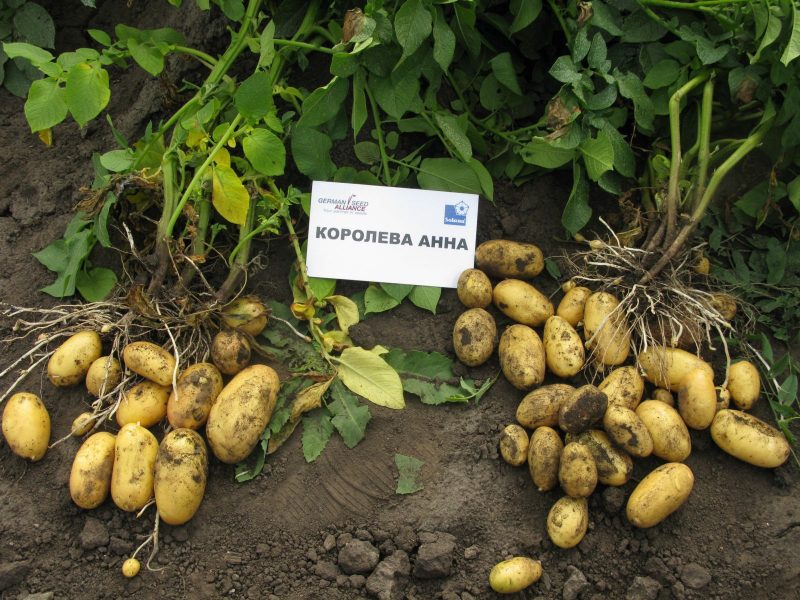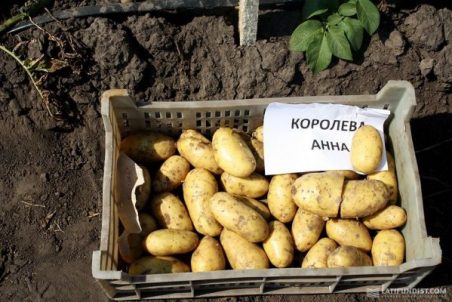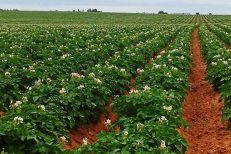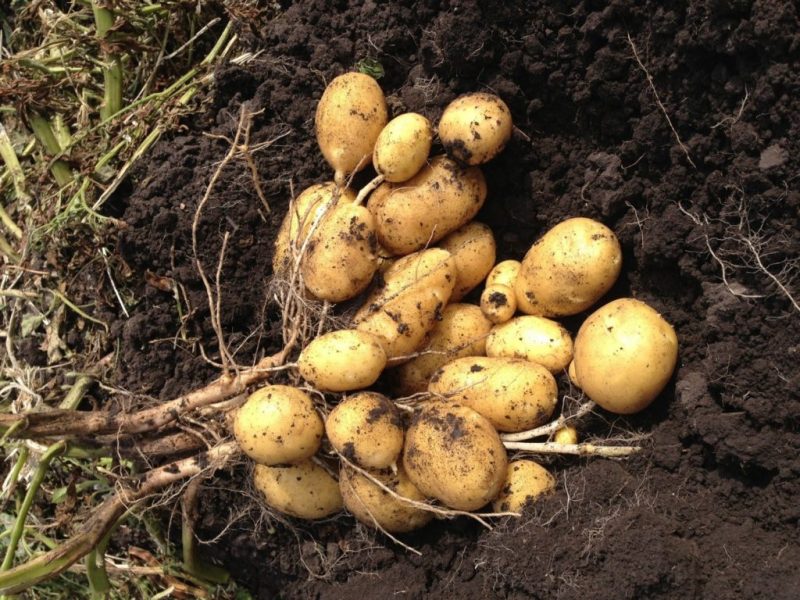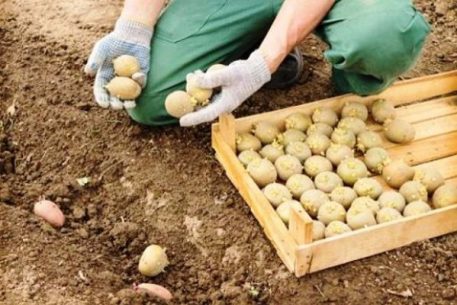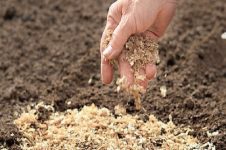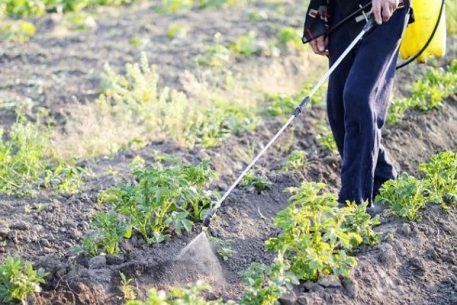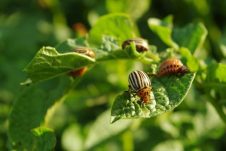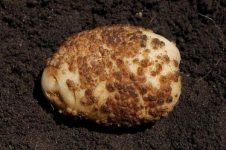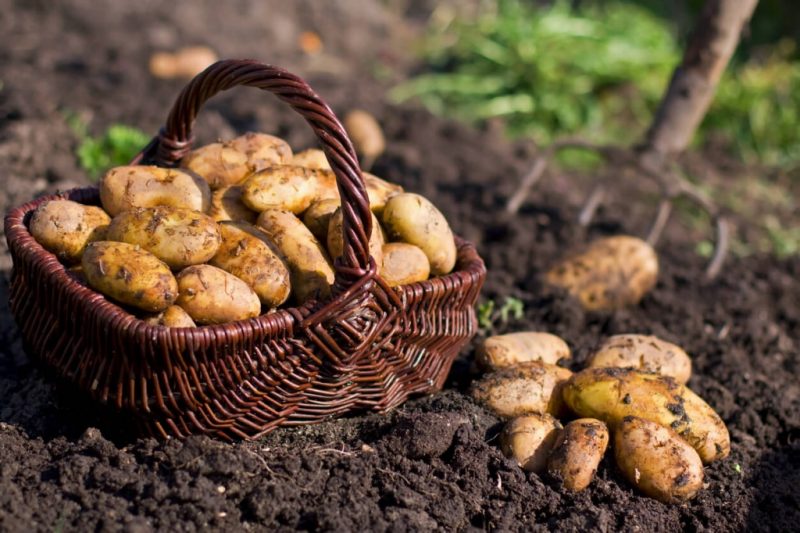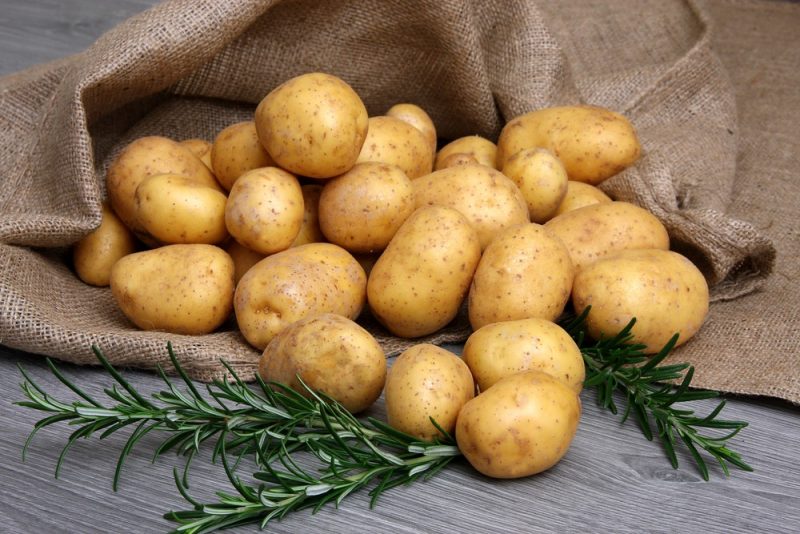Potatoes in Russia are considered an important food product. It is grown in summer cottages, garden gardens. The desire of gardeners is to get a tasty product, a productive variety that is resistant to disease, but not too late. Potato “Queen Anna.” Meets all parameters and is a worthy representative of this culture in the garden.
Material Content:
Description of the seed potato variety
When describing the Queen Anna potato variety, one can highlight its advantages. The bush is of medium height, ordinary potato leaves, large, green. Abundant flowering - white inflorescences. The tubers are long, oval, dense with yellow skin. The pulp is also yellow, hard, the taste is excellent.
Important! The potato retains a pleasant yellow color after boiling, does not darken and does not boil.
Potato “Queen Anna” refers to the early varieties, tubers ripen 70 days after the formation of seedlings.
Here are the characteristics of the variety:
- the weight of one tuber is 85-100 g;
- productivity - 400-500 c / ha;
- the presence of starch - 15%;
- marketability of tubers - 93%;
- crop safety - 90%.
How the Queen Anne variety was developed
This variety was created by scientists-agrarians from Germany. Shows a record yield for potatoes, tolerates adverse growing conditions. He passed adaptation in Russia - he showed all his positive qualities here and was entered in the State Register in 2015.
Advantages and disadvantages of the variety
What are the advantages of Queen Anne potatoes:
- stable high yields;
- excellent taste data;
- good germination of seeds and active ripening of tubers;
- immunity to diseases and pests;
- the possibility of long-term storage;
- excellent transportability;
- the universality of the use of tubers in the nutrition process;
- source of useful elements.
The disadvantages of the variety are difficult to determine, so we can say that they are not.
Potato yield
With good care, Queen Anne potato reaches up to 500 centners per hectare. When grown in a summer cottage, this variety will produce up to 18 full-fledged potatoes from each bush. This figure depends on the diligence of the grower and the weather in the season, but there has never been a case of Queen Anne's low productivity.
Outdoor landing
For the cultivation of Queen Anne potatoes, bright open areas are chosen. Swampy lowlands with close soil waters are not suitable. Heavy soil is not suitable for potatoes. The best will be loamy soil, quite fertile. Although each soil can be improved by fertilizing, compost and humus.
For planting, medium-sized tubers are used, healthy and clean. They are preheated and green in the sun. Furrows are cut after 40-50 cm. Tubers are laid out in them with an interval of 20-25 cm. Plantings are immediately covered with earth, and then mulched with peat.
Cultivation and care
Potato sprouts that have appeared carefully spud, trying not to touch the roots. Hilling protects shoots from frost, promotes the formation of stolons, on which tubers appear and form. Hilling up to 3 times per season.
In a drought, potatoes are watered. This is done at the stage of formation and growth of young bushes and flowering. Aisles loosen and mulch, weed. Usually, all fertilizers are applied when planting potatoes, later on you can use infusions of manure or bird droppings, liquid solutions of mineral salts of nitrogen, phosphorus and potassium, spilling the aisle.
Variety-typical diseases and pests
Early varieties of potatoes are harvested before the development of late blight on its bushes. Nevertheless, in cold, wet summers, this misfortune can happen with the Queen Anne variety. For the prevention of the disease, copper-based solutions are used. A 1% solution of copper sulfate (a teaspoon per 0.5 l of water) is suitable. Helps to get rid of late blight by spraying the lower leaves and soil under the bushes Zircon and Fitosporin.
The second unpleasant phenomenon for potatoes is scab. It appears when fertilizers are not properly applied to the soil. This disease causes an excess of nitrogen in the earth. A large amount of manure should not be brought under the digging of land for potatoes. When liming the soil, excess calcium may appear, which also causes scab on tubers. In this case, it is important not to exceed the dose of lime necessary for liming the soil.
Among the pests, the most dangerous is the Colorado potato beetle. In a small area, insects can be collected manually; large fields will require chemical treatment. Potato “Queen Anne.” Is an early variety that ripens before the mass spread of the beetle. If you observe crop rotation (do not plant potatoes for several years in a row), this pest can be excluded.
Harvesting and storage
Harvest Queen Anne potatoes in mid-July. The weather should be sunny and dry. Preliminarily mowing the tops in 10-12 days. During this time, further tuber ripening occurs, the peel becomes denser, which increases preservation during winter storage.
In small areas, forks are used to prevent potatoes from being cut. All nodules are selected, without leaving trifles. This will save the soil from the appearance of wireworms and other soil pests. Harvested potatoes are left under a canopy for ventilation and drying. The sun should not fall on the tubers: this will ruin their quality.
For storage of root crops, the most successful place would be a cool dry cellar or basement. It is important to maintain the necessary microclimate there. The temperature should not exceed 4-50FROM.At higher rates, the process of germination of tubers occurs: they become lethargic and tasteless. Even the smallest negative temperatures lead to a deterioration in taste, and in the future to the death of the crop.
An equally important condition is humidity. It should not exceed 85%. Storage boxes with perforated walls are convenient. They can be wooden or plastic. They are set so that there is a gap between them and the walls of the cellar.
Important! Any vegetable storage should be equipped with ventilation. In a small cellar arrange vents in the ceiling. In large storages, systems of supply and exhaust ventilation are used.
Of particular importance is the preparation of seed potatoes. To obtain seeds, choose the most productive bushes. They should have up to 60% large tubers. Use specimens with a size of at least 6 mm in diameter. They should not have signs of disease or damage.
They are first sunken in the sun, then laid out in a bright, dry place to detect hidden diseases for 2 weeks. After this period, a repeated audit of the tubers is carried out. It is useful to spray them with Maxim or Fitosporin preparations to protect against diseases.
Thus prepared seed material is stored in the basement separately from potatoes suitable for nutrition.
Among the varieties used by vegetable growers, Queen Anne potatoes have become quite popular. Along with varieties of domestic selection, it is used by summer residents to get an early harvest. Its cultivation is widespread on farm plantations in the regions of the south and center of Russia. Nowhere has the negative feedback been seen by either producers or the population that uses it for food purposes.


